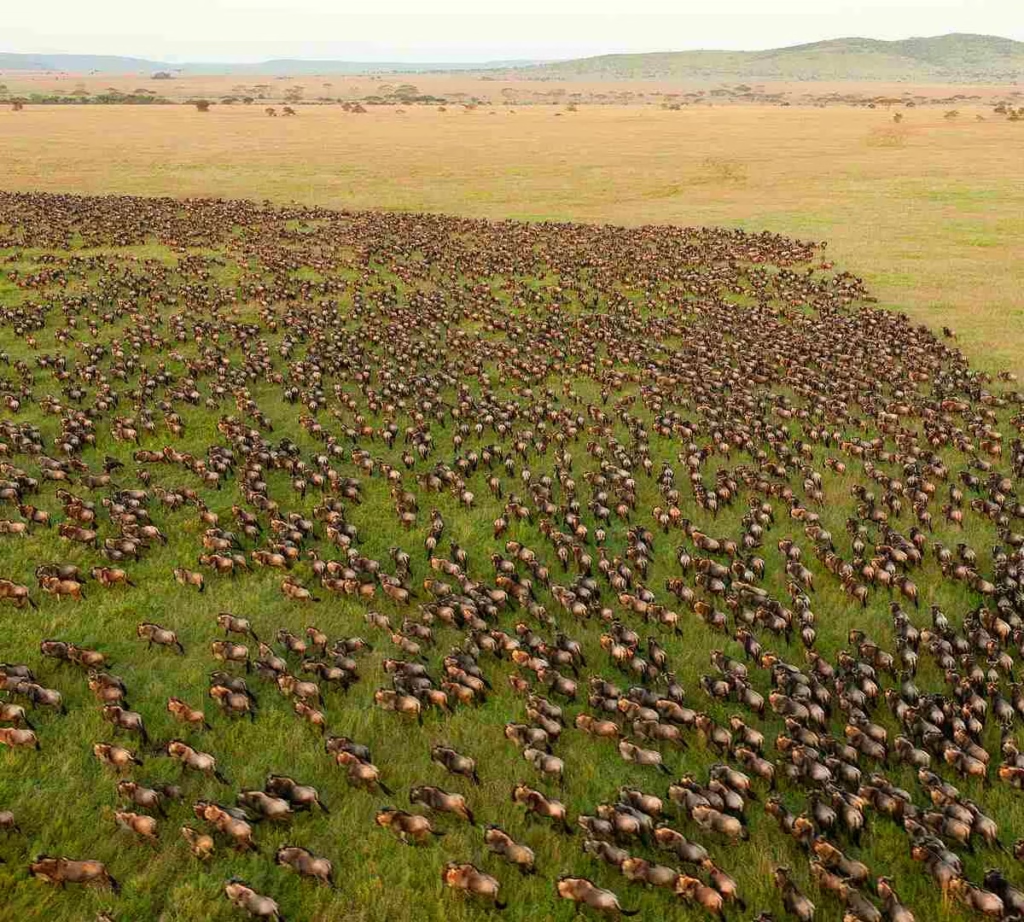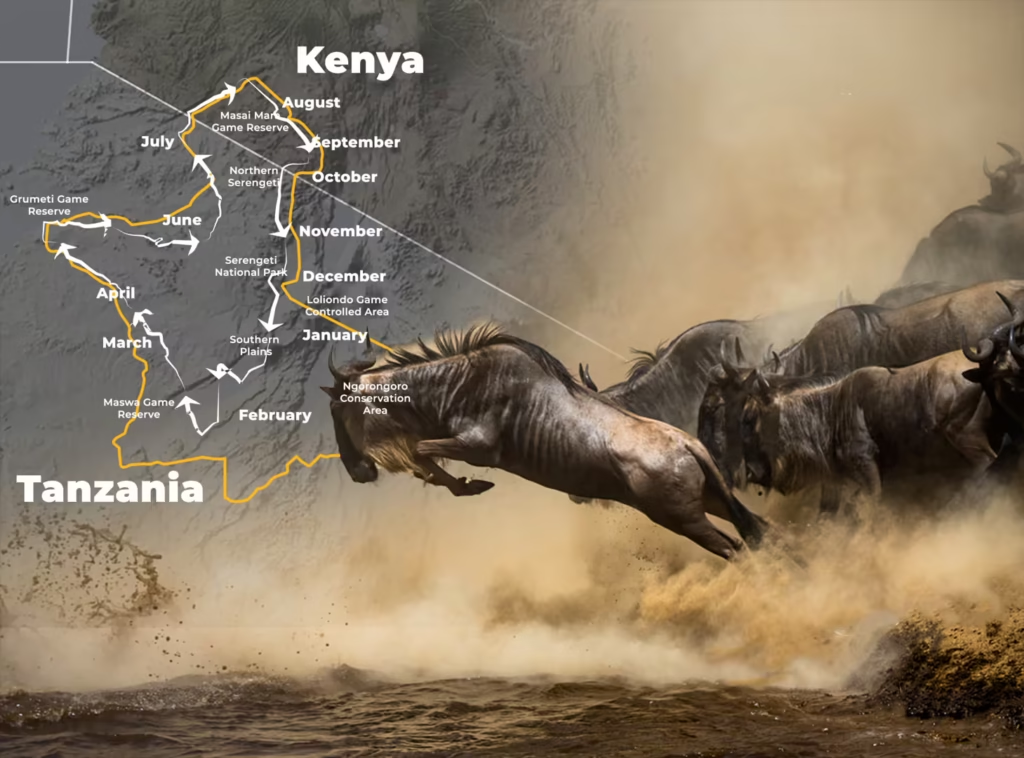Serengeti Wildebeest Migration
Serengeti Wildebeest Migration: Your Expert Safari Guide
Imagine standing on the sun-baked plains of the Serengeti, the air vibrating with the thunderous gallop of over a million wildebeest. Dust swirls around you as zebras dart through the chaos, and distant roars of lions remind you that survival here is a daily drama. This is the Serengeti Wildebeest Migration—a raw, unfiltered spectacle of nature that has captivated adventurers for generations. At Pooja Travel & Tours, we don’t just plan trips; we craft lifelong memories. Let us guide you through this unparalleled journey.

What Is the Serengeti Wildebeest Migration?
The Serengeti Wildebeest Migration is the planet’s most staggering wildlife event, a year-long odyssey where 1.5 million wildebeest, joined by zebras and gazelles, trek 1,200 kilometers across Tanzania and Kenya. Driven by ancient instincts and the pursuit of rain-fed grasslands, this migration is a story of resilience, survival, and the unbreakable bond between predator and prey.
The Cast of the Migration
Wildebeest: The nomadic heroes, whose relentless journey defines the cycle of life in the Serengeti.
Zebras: Nature’s landscapers, trimming tall grasses to expose tender shoots for wildebeest.
Gazelles: Graceful followers, capitalizing on the cleared paths left by the herds.
Predators: Lions, leopards, hyenas, and crocodiles turn the migration into a high-stakes survival game.
The Migration’s Rhythm: A Seasonal Symphony
While nature doesn’t follow a strict calendar, the migration’s pattern is shaped by the rains. Here’s how the drama unfolds:

January–March: New Life on the Southern Plains
The herds congregate in the nutrient-rich grasslands of the Ndutu region. This is calving season—a time of both vulnerability and abundance. Over 500,000 wildebeest calves are born here within weeks, their first steps a race against lurking predators. Tip from Pooja Travel & Tours: Stay at Ndutu Safari Lodge for intimate access to calving grounds.
April–May: The Green Season’s Secret Charm
As heavy rains drench the Serengeti, the herds drift northwest toward the Central Serengeti. The landscape erupts in emerald hues, and tourist crowds thin—a hidden gem for photographers and solitude-seekers.
June–July: The Grumeti River Gauntlet
The migration’s first major obstacle arrives at the Grumeti River. Crocodiles, some over 20 feet long, lie in wait. Witnessing a crossing here is raw and unfiltered—nature at its most primal.
August–October: Mara River’s Deadly Dance
The herds surge into Kenya’s Maasai Mara, where the Mara River delivers heart-pounding crossings. Thousands of wildebeest plunge into crocodile-infested waters, creating iconic scenes featured in documentaries like Planet Earth.
November–December: The Circle Completes
Short rains lure the herds back to the Serengeti’s southern plains, ready to begin the cycle anew.
Your Adventure Awaits – Start Planning Today!
With more than a decade of experience in planning unforgettable Tanzanian experiences, Pooja Travel & Tours is dedicated to ensuring every journey is a seamless blend of adventure, comfort, and discovery. Our team is composed of local experts who have firsthand knowledge of Tanzania’s hidden gems and global consultants fluent in multiple languages. With our team spread across time zones, we provide you with unparalleled support and planning expertise from start to finish.
Why the Serengeti Migration Belongs on Your Bucket List
1. A Front-Row Seat to Nature’s Theater
From lion ambushes to crocodile strikes, the migration is a live-action saga of survival. One traveler described it as “watching a wildlife documentary come to life—but with no pause button.”
2. The Miracle of Calving Season
There’s nothing quite like seeing a wobbly newborn calf take its first steps, only minutes old. The Southern Serengeti becomes a nursery, with predators and prey locked in a delicate balance.
3. Landscapes That Steal Your Breath
The Serengeti isn’t just a backdrop—it’s a character in this story. Golden savannahs, acacia-dotted horizons, and rivers teeming with life create a photographer’s paradise.
4. Cultural Connections
Pair your safari with a visit to a Maasai village. Learn how these pastoral communities coexist with wildlife, and support local crafts through ethical tourism.
When to Go: Timing Your Safari
Peak Action (June–October): For Mara River crossings. Expect crowds—book early!
Calving Season (January–March): Perfect for newborn wildlife and predator action.
Hidden Gems (April–May, November): Lush scenery, lower rates, and solitude.
Where to Witness the Migration
1. Ndutu Region (January–March)
A baby wildebeest’s first steps happen here. Stay at mobile camps like Serengeti Under Canvas for proximity.
2. Seronera Valley (Year-Round)
The Serengeti’s heartland, where cheetahs stalk the plains and leopards lounge in kopjes.
3. Western Corridor (June–July)
Grumeti River crossings are less crowded but equally dramatic. Try Singita Grumeti for luxury amid the wild.
4. Northern Serengeti (August–October)
The Mara River’s iconic crossings unfold here. Our top pick: Sayari Camp, with private terraces overlooking the action.
Crafting Your Safari with Pooja Travel & Tours
Tailored Experiences for Every Traveler
Classic Safaris: 7–10 days of game drives, guided by Maasai experts.
Luxury Expeditions: Helicopter transfers, sundowners on the savannah, and stays at &Beyond’s Serengeti Under Canvas.
Family Adventures: Kid-friendly guides, wildlife tracking lessons, and cultural visits.
Pack Like a Pro
Essentials: Neutral-colored clothing, a zoom lens (70–200mm minimum), and broken-in hiking boots.
Extras: A journal to document your journey—trust us, you’ll want to remember every detail.
Responsible Travel Matters
At Pooja Travel & Tours, sustainability isn’t a buzzword—it’s our promise. We partner with lodges that fund anti-poaching units and hire locally. Travelers can help by:
Using reef-safe sunscreen to protect waterways.
Avoiding souvenirs made from wildlife products.
Choosing eco-friendly lodges like Nomad Tanzania’s Serengeti Safari Camp.

